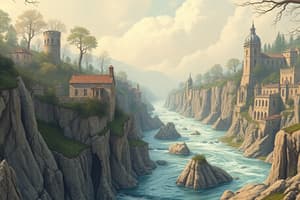Podcast
Questions and Answers
How is a river formed?
How is a river formed?
A river is formed by water flowing downhill from its source, often in upland areas, eventually leading to wider and deeper courses as it travels.
What are the three courses of a river?
What are the three courses of a river?
- Lower course (correct)
- Side course
- Upper course (correct)
- Middle course (correct)
The source of a river is typically found in flat areas.
The source of a river is typically found in flat areas.
False (B)
What are tributaries?
What are tributaries?
What happens to the river's shape as it moves into the middle course?
What happens to the river's shape as it moves into the middle course?
An oxbow lake is formed when a river cuts off its meander, creating a separate ______ body of water.
An oxbow lake is formed when a river cuts off its meander, creating a separate ______ body of water.
What is a floodplain?
What is a floodplain?
An estuary is where a river meets the sea.
An estuary is where a river meets the sea.
What is created when material settles at the mouth of a river?
What is created when material settles at the mouth of a river?
Flashcards are hidden until you start studying
Study Notes
Formation and Course of a River
- A river’s course is divided into three sections: upper, middle, and lower courses.
- The upper course originates in upland regions, often in mountainous areas, where rain and snow lead to downhill water flow.
- In the upper course, rivers are narrow, contain less water, and flow quickly, often eroding rock to form waterfalls and valleys.
- Tributaries, which are smaller streams or rivers that feed into the main river, are formed in the upper course, contributing to the river's strength and speed.
- The confluence is where tributaries meet the main river, enhancing its volume.
Middle Course
- The middle course is characterized by wider and deeper rivers as the terrain flattens.
- Water flow slows down, allowing rivers to meander and create loops and curves due to erosion.
- Over time, meanders can merge and become straighter, leading to the formation of oxbow lakes—isolated bodies of water left behind when a river changes course.
Lower Course
- The lower course sees the river widening and slowing as it approaches flat land, often leading to coastal regions.
- A floodplain forms in this area, which is fertile and favorable for agriculture due to sediment deposits during flooding.
- Alluvium build-up can create levees, which are elevated banks along the river.
- An estuary occurs where a river meets the sea, allowing for the mixing of salt and fresh water, known as brackish water.
- At the river's mouth, sediment settles as the river slows, forming a delta with multiple branching channels leading into the sea.
- Eventually, the river discharges into an ocean or sea, completing its journey.
Studying That Suits You
Use AI to generate personalized quizzes and flashcards to suit your learning preferences.




